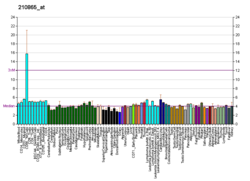Fas ligand (FASL or CD95L) is a type-II transmembrane protein expressed on various types of cells, including cytotoxic T lymphocytes, monocytes, neutrophils, breast epithelial cells, vascular endothelial cells and natural killer (NK) cells. It binds with its receptor, called FAS receptor (also called CD95) and plays a crucial role in the regulation of the immune system and in induction of apoptosis, a programmed cell death.[5]
- ^ a b c GRCh38: Ensembl release 89: ENSG00000117560 – Ensembl, May 2017
- ^ a b c GRCm38: Ensembl release 89: ENSMUSG00000000817 – Ensembl, May 2017
- ^ "Human PubMed Reference:". National Center for Biotechnology Information, U.S. National Library of Medicine.
- ^ "Mouse PubMed Reference:". National Center for Biotechnology Information, U.S. National Library of Medicine.
- ^ Krippner-Heidenreich A, Scheurich P (2006). "FasL and Fas. Typical Members of the TNF Ligand and Receptor Family". Fas Signaling. Medical Intelligence Unit. Boston, MA: Springer. doi:10.1007/0-387-34573-6_1. ISBN 0-387-34573-6.





